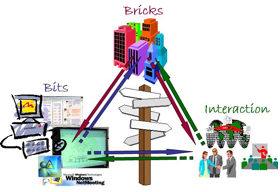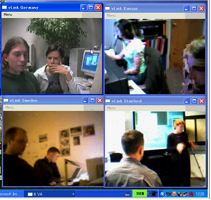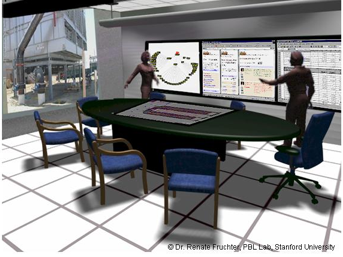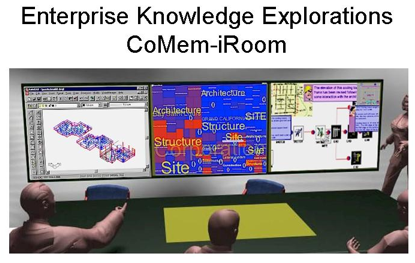Brick & Bits & Interaction (BBI)
Renate Fruchter
1999-2001
In today's information technology (IT) and communication intensive environment people, technology, and build environment designers, and organizations are challenged to understand the impacts on the workspace, content that is created and shared, and social, behavioral and cognitive aspects of work, play, learning, and community. The study is at the intersection of the design of physical spaces, i.e., bricks, rich electronic content such as video, audio, sketching, CAD, i.e., bits, and new ways people behave in communicative events using affordances of IT augmented spaces and content, i.e., interaction. The study presents an integrated approach that takes into account the three perspectives - bits, bricks, and interaction and builds on two hypotheses.
Brick & Bits & Interaction Hypothesis: If we understanding the relationship between bricks, bits, and interaction we will be able to
- design spaces that better afford communicative events,
- develop collaboration technologies based on natural idioms that best support the activities people perform,
- engage people in rich communicative experiences that enable them to immerse in their activity and forget about the technology that mediates the interaction.
- the design and location of spaces in which people work, learn, and play.
- the content people create in terms of representation, media, interrelation among the different media, the content’s evolution over time so that it provides context and sets it in a social communicative perspective.
- the interactions among people in terms of the individual’s behavior, interaction dynamics, new communication protocols, collaboration processes; relation between people and affordances of the space; and interactivity with the content.
Fruchter, R. (2001) “Bricks & Bits & Interaction,” Special Issue on “Exploring New Frontiers on Artificial Intelligence,” Eds. Takao Terano, Toyoaki Nishida, Akira Namatame, Yukio Ohsawa, Shusaku Tsumoto, and Takashi Washio, in Lecture Notes on Artificial Intelligence (LNAI) 2253, Springer Verlag, December 2001, 35-42.
Cone of Interaction (COI)
Humberto Cavallin and Renate Fruchter
1999-2003
This study presents ongoing research towards understanding the discourse and workspace in computer-mediated interactions. We present a series of methods developed to study non-collocated computer-mediated interactions. These methods were developed originally to study interactions involving teams composed of architecture, engineering, and construction management students as part of the AEC Global Teamwork course offered at Stanford University in collaboration with universities worldwide since 1993. The methods stress the value of using ethnographic approaches, particularly the role that both discourse and workspace have in developing the communication processes involved in the interactions. We used the AEC Global Teamwork course as a testbed and focused on issues regarding the nature of the communication act in building design projects when mediated by computers. We successfully tested these new methods.
One of the interesting findings led to the formalization of the notion of cone of interaction. The analysis focused on the environmental aspects present in the interaction, e.g., the analysis of the participants’ movements in the space. From the observations, one important aspect in understanding part of the behavioral patterns of the participants was the study of the workspace used in the interactions. It was reduced to the area surrounding the PC, creating a restricted interaction space. The affordances of the equipments used also determined the way in which the participants used the space. Particularly, two aspects were relevant in the way in which people use the workspace: the locations of the monitor and the video camera. Both Monitors and Video cameras define preferred locations for participants that narrow the possibilities for using a certain area in the working space. When analyzing the movements of the participants in relation to the location of the equipment, we can see that the movements are restricted to a triangular area, that we have called Cone of Interaction (COI). The figure shows the movements of two participants during a real interaction. We identified four major areas in the COI: Command area (A) the area in which the person that leads the interaction is located. The position has to do most likely with the use of the input device, and it is all the way around in the case of left-handed users; Secondary area (B) is the area occupied by default by the other person or people involved in the interaction; Pointing devise (p), Microphone area (m). Key aspects have to be considered in relation to the COI. On one hand, the overlapping of functional areas created by the video camera and the monitor. This overlapping creates three zones as shown in the figure: the sector (1) defines the area in which the user of the computer can have visibility of the screen and be captured by the lens of the video camera; the sector (3) is the area in which no visibility can happen, both for the user of the computer and for the receiver of the image captured by the video camera. However, the sector (2) is potentially most problematic of all, because when being in this area the user of the system can have visibility of the computer screen, but at the same time be out of the camera range without noticing it, creating a visual contact failure in the communicational process.
Fruchter, R., Cavallin, H. and Martin, W.M., (2000) “TO SEE OR NOT TO SEE: The role of visibility and awareness in videoconference-mediated teamwork,“ Proc. of ASCE ICCCBE-VIII Conference, ed. R. Fruchter, K. Roddis, F. Pena-Mora, Stanford, August 14-16, 2000, CA.
Fruchter, R., and Cavallin, H., (2004) “Understanding Discourse and Workspace in Distributed Computer Mediated Interaction,” Proc. of SID2004 3rd Social Intelligence Design, Netherlands, CD.
Fruchter, R. and Cavallin, H., (2006) “Developing methods to understand discourse and workspace in distributed computer mediated interaction,” International Journal of AI & Society, Vol 20,169-188.
Degrees of Engagement
Renate Fruchter
2003-2006
This project presents a new perspective of the impact of collaboration technology on the degrees of engagement and specific interaction zones in interactive workspaces. The study is at the intersection of the design of physical work spaces, i.e., bricks, rich electronic content such as video, audio, sketching, CAD, i.e., bits, and new ways people behave in communicative events, i.e., interaction. The study presents:
- an innovative multimodal collaboration technology, called RECALL, that supports the seamless, real-time capture of concept generation during project brainstorming and project review sessions,
- the deployment of RECALL in an interactive workspace that supports real project review sessions called Fishbowl.
- the observations of the impact of RECALL and the interactive workspace on degrees of engagement and interaction zones as it is deployed in the specific Fishbowl sessions.
Fruchter, R., (2005) “Degrees of Engagement,” International Journal of AI & Society, Springer Verlag, Vol 19, 8-21.
Fruchter, R., (2006)“The FishbowlTM: Degrees of Engagement in Global Teamwork,” I.F.C. Smith ed., LNAI 4200 “Intelligent Computing in Engineering and Architecture,” Springer Verlag, 241-257.
Interaction and Visibility
Milton Chen, Chika Ando, and Renate Fruchter
2002-2003
This project presents a study of the use of an innovative videoconference system called the Virtual Auditorium(VA) (currently VSEE from vseelabs.com) as
- a key component for communication and collaboration, i.e., to support and strengthen discourse and community building in geographically distributed teamwork, as well as
- a data collection instrument for social studies. The VA technology was tested in a cross-disciplinary, geographically distributed teamwork course offered at Stanford in collaboration with university partners in Europe and US.
- High attention level
- Good social link with all remote participants
-
Spontaneous private conversations
- visible to all
- easier among remote students
- harder for students collocated with instructor and mentors
- timely responsiveness of instructor
- Shared workspaces promote more interaction and discourse
- The “spatial buffer effect”
WILD Interactions
Renate Fruchter and Matt Breidenthal
2003-2004
This experimental seed R&D project explores innovative interaction scenarios among learners, instructors, and mentors mediated by new Wireless Interactive Learning Devices (WILD) 30 Siemens SIMPad CL4s (donated by Microsoft) augmented by cutting edge collaboration technologies developed by the PBL Lab research team at Stanford. The hypothesis of this study is that the integration of seamless mobile connectivity, WILD, and collaboration technologies that facilitate creation, capture, sharing, and re-use of rich contextual knowledge will increase the number, quality, and timeliness of interactions among learners, between learners and instructors or mentors. Consequently, it will add value to the learning process and to the final quality of the product. The objective is to develop, test, deploy, and assess a radically new PBL WILD ecosystem. The PBL WILD ecosystem will integrate the Stanford wireless network infrastructure, WILD, and PBL Lab multimodal collaboration technologies that support knowledge creation, capture, sharing, and re-use anytime anywhere. The R&D effort will take advantage of the latest Windows CE.net, Visual Studio.net, and Windows Embedded development environments and tools.
Think Tank - iRoom
Kushagra Saxena, Mahesh Hardikar, and Renate Fruchter
Sponsored by : PBL Lab, Obayashi Corporation
2003-2004
Architecture, Engineering, Construction (A/E/C) team members, while collaborating on building projects, rely on past experiences and content through the use of project design archives (whether in paper or digital format). Underutilization of potential knowledge in the decision-making process of data, information, and knowledge reuse is limited by access to these archives, due to sheer size, decontextualized content, and inconvenient access and presentation. This paper presents an integrated solution called ThinkTank-iRoom that leverages two technologies ThinkTank and iRoom (interactive Room) developed at Stanford. CoMem-iRoom addresses critical limitations, i.e., content, context, visualization and interactivity, constraining the process of collaborative exploration towards knowledge reuse and decision-making.
CoMem-iRoom
Kushagra Saxena, Matt Breidenthal, Peter Demian, and Renate Fruchter
2003-2005
Architecture, Engineering, Construction (A/E/C) team members, while collaborating on building projects, rely on past experiences and content through the use of project design archives (whether in paper or digital format). Underutilization of potential knowledge in the decision-making process of data, information, and knowledge reuse is limited by access to these archives, due to sheer size, decontextualized content, and inconvenient presentation. This project developed an integrated solution called CoMem-iRoom that leverages two technologies CoMem (Corporate Memory) developed by the PBL Lab at Stanford and iRoom (interactive Room) developed by the human computer interaction (HCI) group in the Computer Science Department at Stanford. CoMem-iRoom addresses critical limitations, i.e., content, context, visualization and interactivity, constraining the process of collaborative exploration towards knowledge reuse and decision-making. The CoMem -iRoom can facilitate effective exploration and comparative studies of rich content in context during project team meetings.
Fruchter, R., Saxena, K., Breidenthal, M., and Demian, P. (2007) “Collaborative Exploration in an Interactive Workspace,” AIEDAM International Journal, Special issue on “Support for Design Teams,” Vol. 21, Nr. 3, 279-293.





